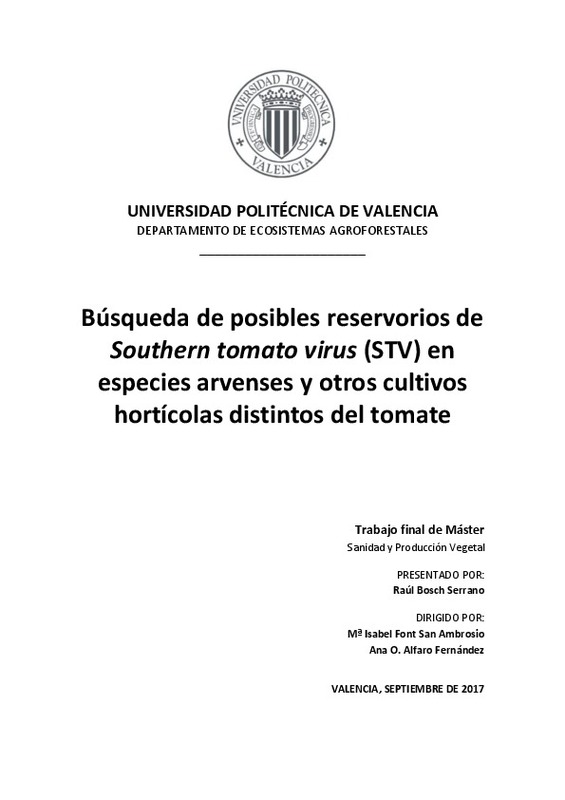|
Resumen:
|
Southern tomato virus (STV) is a virus whose genome consists of a 3.5 Kb double stranded RNA molecule. This virus is phylogenetically related to the Totiviridae (contains nematode and protozoan viruses) and Partitiviridae ...[+]
Southern tomato virus (STV) is a virus whose genome consists of a 3.5 Kb double stranded RNA molecule. This virus is phylogenetically related to the Totiviridae (contains nematode and protozoan viruses) and Partitiviridae (containing fungal and plant viruses). It is part of a group of viruses that constitute the new genus Almalgavirus (family Amalgaviridae) cataloged as a group of cryptovirus. STV is not transmitted mechanically or by grafting, but by seed, with a very high efficiency that can reach 90% or more. Since its first detection in Spain in tomato crops in 2013, it has been detected in many tomato plantations of commercial and local varieties of different producing areas. The pathogenic role of this virus is not yet well defined, as it has been frequently detected in asymptomatic plants and in mixed infections with other tomato viruses in symptomatic plants.
The aim of this work is to analyze different weeds sampled in tomato fields with STV of the island of Gran Canaria to determine if they can be hosts of this virus and thus be able to act as reservoir of the same. For the development of the assay, ribonucleic acid (RNA) will be obtained from each sampled plant to be analyzed by molecular technique RT-PCR with STV-specific primers.
In addition, seedlings of other horticultural crops, with the same molecular technique, will also be analyzed in this study to determine if STV is present in other crops besides tomato.
[-]
El virus meridional del tomate (Southern tomato virus, STV), es un virus cuyo genoma consta de una molécula de RNA de doble cadena de 3.5 Kb. Ese virus está relacionado filogenéticamente con las familias Totiviridae (contiene ...[+]
El virus meridional del tomate (Southern tomato virus, STV), es un virus cuyo genoma consta de una molécula de RNA de doble cadena de 3.5 Kb. Ese virus está relacionado filogenéticamente con las familias Totiviridae (contiene virus de nematodos y protozoos) y Partitiviridae (que contiene virus de hongos y plantas). Forma parte de un grupo de virus que constituyen el nuevo género Almalgavirus (familia Amalgaviridae) catalogado como un grupo de criptovirus. STV no se transmite de forma mecánica ni por injerto, pero sí por semilla, con una altísima eficiencia que puede alcanzar el 90% o más. Desde su primera de detección en España en cultivos de tomate en 2013, se ha detectado en numerosas plantaciones de tomate de variedades comerciales y locales de distintas zonas productoras. El papel patogénico de este virus aún no está bien definido, ya que se ha detectado con frecuencia en plantas asintomáticas y en infecciones mixtas con otros virus de tomate en plantas sintomáticas.
El objetivo de este trabajo es analizar diferentes especies arvenses muestreadas en campos de tomate con STV de la isla de Gran Canaria para determinar si pueden ser hospedantes de este virus y poder así actuar como reservorio del mismo. Para el desarrollo del ensayo, se obtendrá el ácido ribonucleico (RNA) de cada planta muestreada que se analizarán mediante la técnica molecular RT-PCR con cebadores específicos de STV.
Además, también se analizarán en este trabajo plántulas de otros cultivos hortícolas, con la misma técnica molecular, para determinar si el STV está presente en otros cultivos además del tomate.
[-]
|







